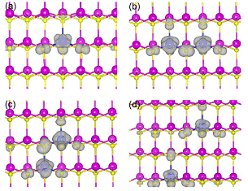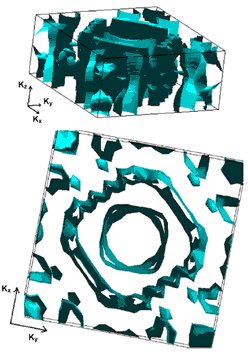Research programme

Calculations for ZnO semiconductor doped by Ag atoms: Spin density for (a) the relaxed geometry of isolated Ag, (b) for the nonrelaxed NN pair oriented in the (x, y) plane and (c) along the c axis, and (d) for the relaxed distant pair. Small (yellow), medium (magenta), and large (blue) balls represent O, Zn, and Ag atoms, respectively. (VASP results)
The main tasks of the Division are investigations of electronic, magnetic and transport properties of nano- and microscopic systems with special emphasis on new materials and search for new ideas for advanced nanotechnology. The recent investigations are focused on the following materials:
- f-electron systems: uranium and rare earth intermetallics, with interesting physical properties (heavy fermion, Kondo like and mixed valence systems);
- Heusler type alloys, especially interested for their half-metallic transport properties and potential applications in spintronics;
- semiconductors: ZnO, an II-VI oxide semiconductor, a promising material for various technological applications, especially for optoelectronic light-emitting devices in the visible and ultraviolet range of the electromagnetic spectrum;
- TiNi, -LaNi5- and Mg2Ni-type phases are studied in relation to their exceptional hydrogenation properties, especially magnesium-based hydrogen storage alloys have been also considered to be possible candidates for electrodes in nickel-hydride (Ni-MH) batteries;
- BiFeO3 bulk and thin film, heterostructure, nanostructure multiferroics, i.e. materials that show simultaneous ferroelectric, ferromagnetic and ferroelastic ordering, therefore they are very promising candidates for advanced sensors and new technologies.
Using ab-initio methods we determine electronic spectra, magnetic structure and X-ray photoemission spectra in order to understand complex quantum interactions and to search for materials with optimal features for applications. In the ab-initio calculations the following methods are used: VASP, Wien2k (FP LAPW), FPLO, SIESTA, FP LMTO, and SMEAGOL for transport in molecular junctions. Our computational facilities contain two main clusters: the first one based on the AMD Opteron and Phenom processors (72 cores) and the second one based on Intel Xeon (53xx series, 128 cores as well as 55xx series, 48 cores).

Fermi surface of UAuSb
2; upper panel: view from the (k
x, k
z ) plane; lower panel: view from the kz direction Results obtained based on FP LMTO method.
Moreover we study fundamentals of electronic transport in nanostructures, especially:
- charge and spin configurations in complex nanosystems in magnetic and electric fields (taking into account many body states and the symmetry of the system);
- spin-dependent transport through quantum dots, wires and molecular junctions;
- charge and spin dynamics, current correlations in nanostructures;
- influence of Coulomb, magnetic and spin-orbit interactions, quantum interference and Kondo physics on transport characteristics.
In general the nanostructures are described by models taking into account specific interactions and physical properties are determine by means various methods, e.g. the non-equilibrium Green function technique to calculate currents and shot noise. These problems are crucial for development of spintronics, a new field of electronics, in which the spin of individual electrons may play an important role in storage, transfer, and manipulation of information.
Our theoretical studies stimulated research in nanodevice and the predicted effects were seen in many experiments. Let us mention as an example, the studies of the Fano and Kondo resonance in a multilevel quantum dot, discovery of the dynamical Coulomb blockade effect and bunching of electrons in nanostructures. Ab-initio results were successfully verified by X-ray photoelectron and neutron spectroscopies, and investigations of the phase stabilities were valuable instruction in search for new hydrogen storage materials.


